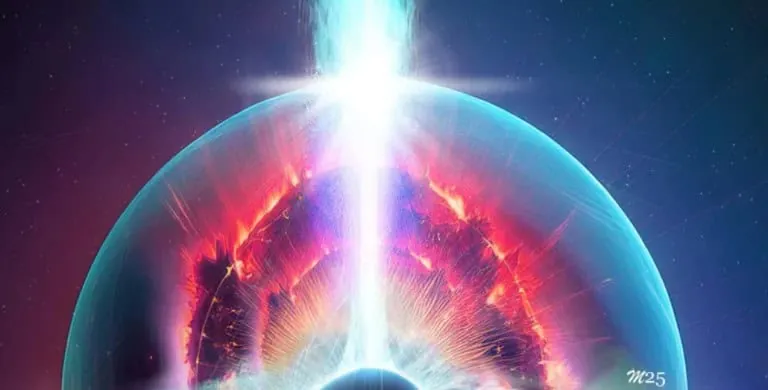
Dying Stars Reveal Secrets of Heavy Element Creation: New Photon Collision Model
2025-04-12
Author: Siti
Unveiling Cosmic Secrets at Los Alamos
In a groundbreaking revelation, physicist Matthew Mumpower from Los Alamos National Laboratory and his team have proposed a model that could illuminate the mysterious process behind the formation of heavy elements in collapsing stars. This intriguing research suggests that the energetic photons emitted by newly born black holes or neutron stars can transform protons in stellar ejecta into neutrons, setting the stage for the creation of heavy elements.
The R-Process: Unlocking Elemental Mysteries
Astrophysicists have long believed that the universe's heavier elements, those denser than iron, are forged in extreme cosmic events like massive star explosions and neutron star mergers. A key process in this elemental birth is the rapid neutron-capture process, commonly known as the r-process. However, the exact locations where this process takes place have remained enigmatic.
As Mumpower eloquently points out, The r-process must happen in environments rich in free neutrons, yet these neutrons are notoriously unstable, decaying within roughly 15 minutes. Identifying environments that can quickly produce and utilize these fleeting neutrons is pivotal, and one of the paramount challenges in modern physics.
Creating Neutrons from Light
In an engaging twist, Mumpower's research explores how massive stars, collapsing into neutron stars or black holes, can generate substantial amounts of neutrons. Their focus lies on the intense bursts of light emitted during the collapse, which includes highly energetic gamma rays.
These bursts are directed along tight jets that shoot outward from the poles of the collapsing star's core. As these jets travel through the surrounding ejected stellar material, they create a hot, dense cocoon of material. Within this unique environment, Mumpower's team posits that energetic photons collide with protons, resulting in the creation of neutrons and pions. Because neutrons carry no charge, they can easily merge into the cocoon, fostering ideal conditions for the r-process.
Potential for Elemental Creation: Gold, Platinum, and Beyond!
By conducting detailed computer simulations, the researchers estimated that this light-induced process could produce a large volume of free neutrons. Mumpower states, We discovered that this photon collision mechanism could generate enough neutrons for the synthesis of heavy elements, including gold, platinum, and potentially even heavier elements not yet discovered.
Connecting Cosmic and Quantum Realms
If validated, this model could bridge the fields of high-energy particle physics, often studied at the Large Hadron Collider, with low-energy astrophysics that delves into stellar formation. Mumpower emphasizes, This research intertwines two areas of study that rarely converge, enhancing our understanding of how heavy elements are born in the cosmos.
Exploring Cosmic Phenomena
Mumpower's findings may also provide fresh insights into various cosmic phenomena. For instance, they propose a compelling explanation for why some cosmic events, particularly long-lasting gamma-ray bursts, are frequently followed by kilonova explosions, characterized by the luminous decay of new heavy elements. It might also clarify the striking similarities in heavy element distribution found in ancient stars throughout the galaxy.
Implications for Earth's Deep-Sea Chemistry
Moreover, this research could enhance our comprehension of the chemical composition of Earth’s primordial deep-sea deposits, which contain both iron and plutonium, suggesting a shared origin from similar cosmic events.
As the team continues refining their model through advanced simulations, they aim to further unravel the intricate, dynamic processes occurring during the collapse of massive stars, potentially rewriting our understanding of the cosmos.


 Brasil (PT)
Brasil (PT)
 Canada (EN)
Canada (EN)
 Chile (ES)
Chile (ES)
 Česko (CS)
Česko (CS)
 대한민국 (KO)
대한민국 (KO)
 España (ES)
España (ES)
 France (FR)
France (FR)
 Hong Kong (EN)
Hong Kong (EN)
 Italia (IT)
Italia (IT)
 日本 (JA)
日本 (JA)
 Magyarország (HU)
Magyarország (HU)
 Norge (NO)
Norge (NO)
 Polska (PL)
Polska (PL)
 Schweiz (DE)
Schweiz (DE)
 Singapore (EN)
Singapore (EN)
 Sverige (SV)
Sverige (SV)
 Suomi (FI)
Suomi (FI)
 Türkiye (TR)
Türkiye (TR)
 الإمارات العربية المتحدة (AR)
الإمارات العربية المتحدة (AR)